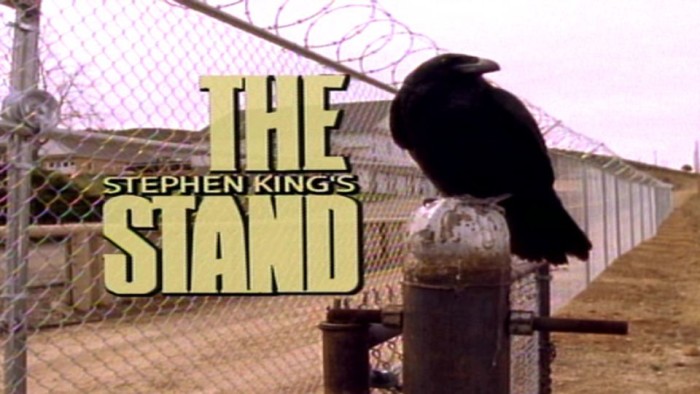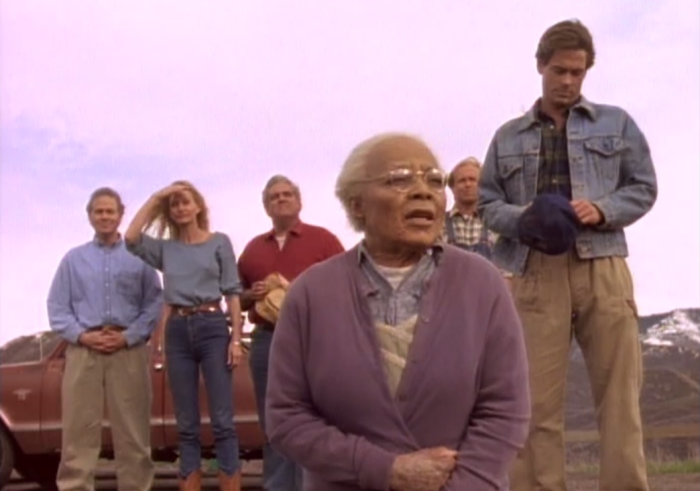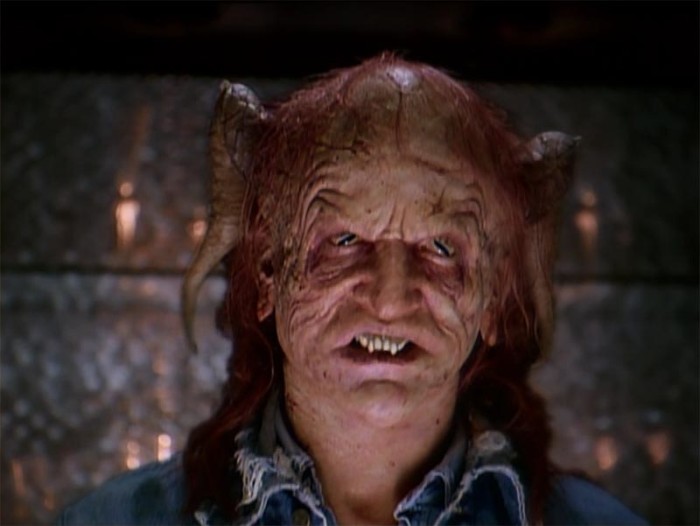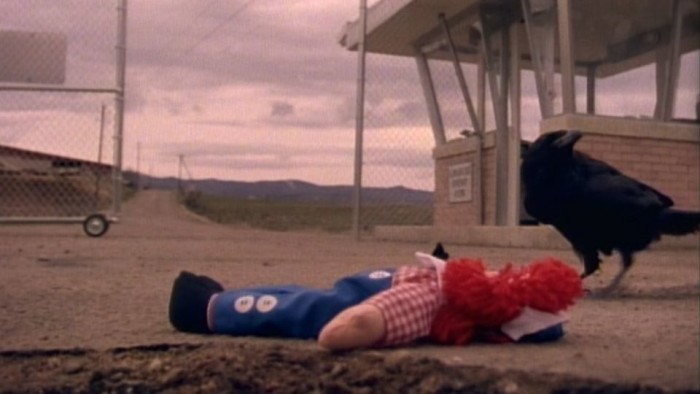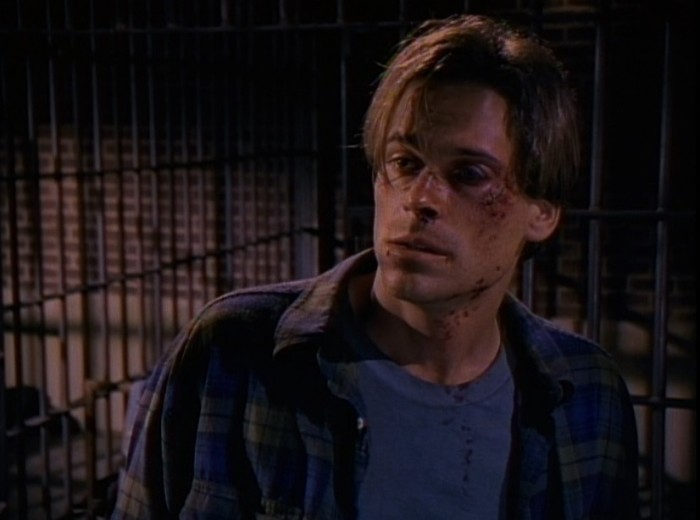'The Stand' Revisited: Does Stephen King's End Of The World Hold Up Over 20 Years Later?
(Welcome to Nostalgia Bomb, a series where we take a look back on beloved childhood favorites and discern whether or not they're actually any good. In this edition: does the television miniseries adaptation of The Stand represent the pinnacle of Stephen King adaptations or...not.)
If you grew up between 1950 and 1990, you knew how the world would end.
The United States and the Soviet Union would press a few buttons, and aliens would sift through the radioactive ashes. Rod Serling told us all about it. Dr. Strangelove put clown shoes on it. School children learned pointless ways to defend against it. There was a bone-deep helplessness that came with the fear, not just of the end of your life, but of all life itself, floating in the back of your head at all times.
Right after I was old enough to be made aware of that fear, it disappeared. The Wall came down, the Soviet Union collapsed, and we Americans were forced to open our minds to new ways of destroying the entire population.
Stephen King's The Stand straddles these immobilizing periods by existing in different forms. The first, a Cold War novel about the collapse of society following a massive government blunder; the second a post-Cold War miniseries about the collapse of society following a massive government blunder.
The Cold War and the Superflu
Told in four chapters, the miniseries begins with the release of a U.S. government-crafted Superflu (first called Project Blue and later nicknamed Captain Trips) whose devastation is near-total. The hundred or so survivors are pressed by dream visions to migrate to one of two places: a serene farm in Nebraska run by an 106-year-old Moses figure named Mother Abagail (Ruby Dee) or a Las Vegas strip lorded over by the demonic antichrist wizard Randall Flagg (Jamey Sheridan). The outbreak nightmare gives way to a post-Apocalyptic tale of two cities. One is, wait for it, a kind of collectivist democracy inhabited by the good-intentioned while the other is a resource-poor dictatorship catering to fleshy corruption.
As with a lot of art, the story's face shifted because our personal baggage changed. The book's calamitous Superflu emergency – though inspired by actual chemical weapon accidents like the Dugway sheep incident – could have been read when it hit shelves in 1978 as a morality tale about government overreach simply because all art that even orbited near the concept fell into a symbolic, critical black hole created by the Cold War. The conflict was reflected in everything, and everything was reflected in it.
A story about the United States government accidentally triggering the near-extinction of humankind? King might as well have included Major Kong yeehaw-ing Fat Man down to earth at the end of the book.
With the Cold War over in 1991, the 1994 miniseries version of the novel's existential villain returned to its literal form to terrify us not as a symbolism for mutually assured destruction, but as the inevitable viral outbreak we expected would happen after narrowly escaping the shadow of the bomb. This was a parallel fear of the age marked most notably by AIDS and the initial Ebola outbreak in the mid-1970s that continued after the Soviet Union perished.
Watching the End of the World with Young Eyes
Since I don't remember the events of my childhood in chronological order, there's a haze of viral terror in my memory of which The Stand seemed at the center. In reality, The Stand miniseries became a kind of cyclical cultural artifact because it was based on a 1970s book, inspired by outbreaks of the time which eventually returned to haunt us in the mid-1990s; Ebola was all over the news a year after The Stand aired when a devastating outbreak in what was then Zaire killed hundreds. Fresh fear on our evening screens. Art becoming prescient as history plays on repeat.
My brother was also diagnosed with a terminal illness in 1991, and we spent a good part of the time afterward driving four hours up the coast to specialists in Houston, living in hospital rooms, and playing with Super Mario Bros. Happy Meal toys on the papery sheets of beds with wheels on them. We had oxygen tanks in our house which were as tall as I was, and I heard terms like "pulmonary" and "hypertension" years before I understood what they meant. Dying and disease weren't abstract concepts, but things I shared a room with.
My brother's diagnosis at the time was a dire thing marked by doctors' shaking heads and shrugging shoulders, so there was little space for optimism. But then he kept on living.
The Stand hit television two years later, when I was nine years old, and it captivated me. We didn't have much appointment TV outside of Home Improvement and seaQuest DSV, and the 4-night destruction of society was a special event. Something you made popcorn for. Something that instilled in me a lifelong fascination in the Apocalypse at a young age. It was the gateway drug for The Twilight Zone, and the reason I wanted to see Twelve Monkeys and Outbreak when they hit theaters a year later. (I had to wait a while for those.)
It was also an event in the sense that I didn't get to see it again, to puzzle over it outside of my own memory, until years later. If it played on TV again after that, I must have missed it, and we didn't buy it when it hit VHS, I'm guessing, because it was too pricey. In the pre-streaming era, it became a singular experience.
For those four consecutive nights in mid-May, I was glued to the television. At the time, I remember everything about it being intense, severe, and fantastically weird. I stared wide-eyed at the self-strangling of humankind and recognized, through Vacation Bible School lessons, the ancient struggle between the humble faithful and the selfish destroyers.
The allegorical figures were steroidal to me at that age. I was a kid, so nuance was a few years off. Good versus evil, I could grasp, and that's the product it was selling.
Looking back, I wonder if what I needed most from The Stand was reassurance both that the disease was someone else's fault and that someone else, somewhere, was still in control.
What Holds Up and What Doesn't
For the most part, The Stand survives the test of time if you're comfortable with it as a soap opera where billions of people die. King's magical realism is, as ever, a blunt instrument, and in director Mick Garris's hands, we're beaten over the head with it repeatedly. The country-hopping atmosphere feels appropriately epic, falling in line with King's vision to create a Tolkien-esque fantasy set in America, complete with Las Vegas as Mordor, the salt-of-the-earth Texan Stu Redmond (Gary Sinise) and his benevolent libertarian crew as the Fellowship, and dark magician Flagg (a King mainstay who appears in tons of stories, including The Dark Tower) as Sauron. We ride bikes and drive and walk from Maine to the Midwest and from Colorado to California.
The sprawling morality tale is told initially in vignettes that introduce us to a stacked ensemble. Personal stories obliterated by the bug. The casting is so unusual that it's inspired and unfortunate in equal measure.
Teen heartthrob Rob Lowe played Nick Andros, a sedate deaf mute who is almost annoyingly goodhearted. Molly Ringwald played Frannie Goldsmith, a naive, flattened version of her complicated good girl persona from the Brat Pack days. Poor man's Ferris Bueller Corin Nemec played the pimply future Men's Rights Activist Harold Lauder, who pines deeply for Frannie's love from deep in the Friend Zone. Mystic Pizza love interest Adam Storke played the cocky almost-rock star Larry Underwood (a real rock star name!) who straddles the fence between good and evil until maturing on the way out west. Bill Fagerbakke (Dauber!) played Tom Cullen, an intellectually disabled softy who spells everything M-O-O-N and can see visions (like Mother Abagail does) when he gets in a hypnotic state. At the top of the bill, Gary Sinise played Stu Redmond as a Gary Sinise-esque hero Gary Sinising all over the place. Real pre-leg-loss Lieutenant Dan stuff.
And, oh man, there are so many other characters. That's just the core of the good guy squad! As ever, the villains are more interesting to watch. Laura San Giacomo played Nadine Cross, a witchy woman seduced by Flagg (and, let's face it, never totally embraced by Team Wholesome). Miguel Ferrer absolutely owned as Lloyd Henreid, a spree killer who becomes the besuited right-hand sleaze to Flagg. Matt Frewer played Trashcan Man, a schizophrenic force of chaos whose Flagg-worshipping mantra becomes "My life for you!" which he yells while roaming the desert trying to find a super fun nuclear bomb to bring home to the Copacabana.
Then there's Flagg, an inter-dimensional embodiment of evil played at intervals by Sheridan, Sheridan in the best rubber grotesque masks of the time, and an insanely well-trained crow.
The World at the End
The production design works best when it's utilizing the natural landscape to sell the environment, although hospital and military sets are particularly convincing in their fluorescent disquiet. The cornfield built for the dream sequences (which gave the crew legendary headaches) looks sound stage fake, but it either kind of works to enhance the alienation effect of each character's unintentional ESP or I'm being generous to it in an effort to understand why the miniseries still entertains me.
It's unmistakably a television cast in an era when that didn't mean Don Draper, and King's tell-don't-show script doesn't do anyone any favors, but the horrific atmosphere still shines darkly through. The first installment is a steady, tense descent into hell that achieves the hallmark of great horror of turning something small and everyday into something fearsome. Whenever someone coughs, you know they're done. It's a piece of art that makes you scared to clear your throat.
The other big thing The Stand gets right is the graphene thin line between peaceful normalcy and total destruction. The reason Captain Trips escapes the secure military facility to stuff up sinuses worldwide? A gate malfunctions. That's it. A button and some metal.
A scared guard (Ray McKinnon) abandons his post, grabs his family, and hightails it only to become Patient Zero in the podunk town of Arnette, Texas, where Stu Redmond and his immunity call home. One week, everything is normal. The next week, pus-spewing bodies line the streets, and the military is shooting journalists for telling the truth. The next week, there's a lot more space between you and your neighbor.
How I Learned to Start Worrying
The Stand is the story of the United States eating itself.
Despite Flagg's ethereal influence, the government is unequivocally the villain. Or, more specifically, the government's zeal for making war. To find new ways of killing both more effective and more perverse. Captain Trips is a monster of our leader's own making that erodes us from the inside like too-strong stomach acid.
The smirking key (as if it weren't already signal flare obvious) comes when talk radio sarcasm machine Rae Flowers (Kathy Bates in a fun, fantastic cameo) takes calls relaying stories of the military murdering civilians. She cackles in response, "That wouldn't be very American, would it?" as well-armed Marines bust into her building. We hear the report of gunfire on Frannie and her father's (Ken Jenkins) radio as Frannie, eyes wet, mouth quivering, shakes her head in manic disbelief. It can't happen here, right?
Again, this is all sledgehammered into us. The government of The Stand isn't seen as a force for good, but as a secretive, brutish beast that claws to protect itself even against its own citizens, even after it's already fouled up so badly that its borders fill up with bodies. Soldiers continue to carry out orders to stifle talk of the flu, and then to stifle talk about the military's atrocities, which is a frustratingly absurd cycle of pointless mayhem. Even when Stu, Mother Abagail and Team Wholesome set up the socialist-lite Boulder Free Zone, their focus on creating a functional, comfortable society is punished by a traitorous bomb. Abagail declares it just payment for failing to obsessively plan for Flagg's downfall, and the thematic unevenness begins in earnest. They just want clean water and dependable trash collection, but God needs them to prep to execute more violence. If you think about it more than a few seconds, the faith narrative crumbles like so many brittle plastic bottles of Flu Buddy in the landfill.
There are other baseline cringe-worthy sins that come with reviewing a 23-year-old adaptation of a 39-year-old novel, to be sure. For example, Mother Abagail is a textbook "Magical Negro" in a new world of remarkably few non-white people, which feels even more egregious when the lines between good and evil are drawn so simplistically.
This is where I get to the punch line that I'm not simply re-watching something I enjoyed as a child. I'm also re-evaluating an adaptation after reading the much denser, much more complex novel (the shorter 700-page version, not the extended edition King released years later). The Stand miniseries, clocking in at just over 6 hours, succeeds by feeling packed, but it's an illusion that turns to flimsy reality after reading the book and recognizing all the slimming Garris and King had to do to come in under the clock. That 360 minutes is an aggressive condensing project for The Stand makes the 90-minute runtime of The Dark Tower even more absurd, whether you call it a "sequel" or not. Watching them a week apart offers a clear indication that a lot of King's work – the massive mythologies – deserved luxurious stays on the small screen instead of brief dances on the big one.
Digressions aside, where The Stand once felt tense to the point of bursting, it became thin and impoverished after experiencing the novel, robbed of the little human asides and arcs that round out the characters and inject ambiguity into why any of them were drawn to the light or dark sides.
The miniseries – anchored firmly in the black-vest-and-jeans '90s in many, many ways – is a time capsule of suburban fears and idiotic stereotyping. The helpful, tediously decent people gravitate to Mother Abagail without fail, and the looters, drug-doers, flannel-wearers, and criminals (mostly) flock to Flagg. It is good and evil as seen through a kid coming home from hearing a D.A.R.E. presentation at Vacation Bible School.
Yet, somehow, The Stand still offers a lot to love. Maybe because it's an echo of that larger story. Maybe because you can forgive its sins for its limitations. Maybe because it would be great to see TV studios drop the equivalent of $45m on a saga of global rot in the era of Peter Pan Live!. Maybe because disconnecting it from my nostalgia isn't possible, even when I start wincing.
My brother died of his illness a decade after being diagnosed. This was years after I gave up Bible stories for Stephen King books (The Eyes of the Dragon is still my favorite) and got to see Twelve Monkeys and Outbreak and dozens of other stories about the potential collapse of normalcy. I read The Stand my junior year of high school, a year before he died, and was consumed by the expansive version of the doomed world that I already knew.
The squished-yet-extensive miniseries will always be the foundation of that journey. I'm still drawn to the plainness of The Stand's hope as well as, somber as it is, the muscle-unclenching finality that stories about the end of the world bring. The way being late on your credit card payment or spilling coffee on yourself or the spreadsheet you have to make don't matter quite as much after every person in every city starts coughing to death. They're escapism by staring into the lion's mouth, to recognize the neutral inevitability of death, and the pain (and sometimes the end of pain) it brings. They challenge us to imagine what image we'd create the world in if given a chance to start over. To find some sense of healing after losing so much. The Stand, yes, has a cataclysmic loss, but it's story is about the survivors.
I can't imagine it's a coincidence that I said a decade-long goodbye to my brother before graduating high school and that I'm drawn to stories where everyone else on earth loses someone, too.
In the novel, after wrestling with the nature of faith and the questionable resilience of mankind, the story ends with Stu and Frannie questioning whether people are capable of learning from getting that close to extinction. The very last line is, "I don't know," which may as well be an invitation to the Captain Trips 20 Year Reunion. Or it's a Rorschach Test, and I've just revealed my innate pessimism. The question is a worthy one to consider after thinking about a Cold War era relic transformed into a 1990s wasteland drama, and then tuning into the news here in 2017.
The miniseries wraps that existentialism in cotton, closing with a montage of characters lost, an ill-advised floating head of Mother Abagail, and the same question about man changing, followed by Frannie still claiming not to know, but then suggesting that a baby girl born immune to the plague might. The very last image is of a newborn that won't catch the same sickness again.
After all that torment, a fuzzy pink future wrapped in swaddling.

